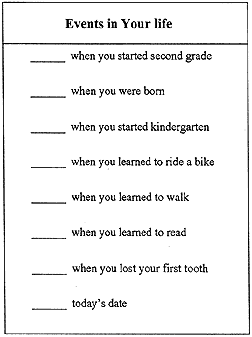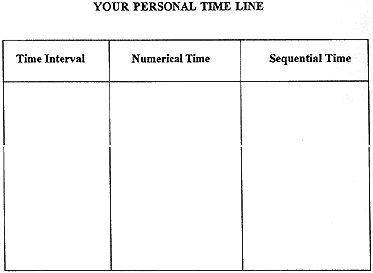SEQUENCING TIMEJUDITH SCOTCHMOORTELLING THE history of the earth requires placing events in sequence so that reference can be given to the relative and/or numerical time at which each event occurred. This helps to make sense out of the enormous expanse of time that has elapsed since the origin of the earth. This activity will help students to understand the methods used by geologists in creating the Geologic Time Scale.
Objectives: Explore this link for additional information on the topics covered in this lesson: MATERIALS1) Each student will need: A copy of the worksheet Events in Your Life.2) A copy of the sheet Your Personal Time Line. (click here to download a pdf version)  PROCEDURESInstruct the students as follows:1) Look at the events listed on the sheet entitled Events in Your Life. Arrange these events in order, by placing the number 1 in front of the event that occurred first in your life, a number 2 for the second, etc. 2) On the worksheet entitled Your Personal Time Line, you will be writing these events in order in the third column, Sequential Time, but you will be writing them so that the most recent event is at the top of the list and the event that occurred first is at the bottom of the list. (Students do not need to write out the entire event. For example: "When you learned to walk" could be written simply as "Learned to Walk".)
Your completed list is now similar to what a geologist might refer to as a Sequential Time
Line. 3) Return to your time line worksheet. In the middle column entitled, Numerical Time, place a zero by today's date. Then think of the number of years ago each event happened. Write these numbers in the column in front of each event. If you can't remember exactly, try to guess and round off to the nearest whole year. These numbers are the numerical ages of the event and make up a numerical time line. Now you can use both the sequential and the numerical information to describe events in your life. Using both of these, describe when you started kindergarten. An example might be: I started kindergarten four years ago, after I learned to walk but before I lost my first tooth.
See if you can describe a single event using the information in all three columns. An example: I started Kindergarten at the beginning of Schoolian time, four years ago... Think of another event which has occurred in your life. For example, the first time that you tasted pizza. You probably cannot remember the exact year when that occurred, but you probably can place it between two events which you can remember. Therefore, you would know its relative time. How could you give it a numerical time?
This activity provides a good introduction to the Geologic Time Scale which has been
arranged (and developed) in a similar manner. If it is used by older students, it is possible to
change the Events and to divide them into three time intervals, such as
Preschoolian, Gradeschoolian, and Postgradeschoolian.
Extensions:
Credits: |

